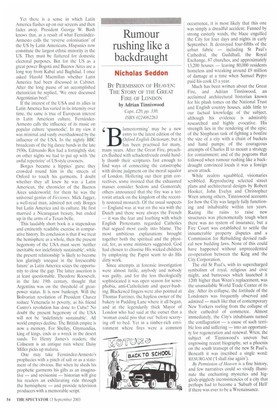Rumour rushing like a backdraught
Nicholas Seddon
BY PERMISSION OF HEAVEN: THE STORY OF THE GREAT FIRE OF LONDON by Adrian Tinniswood Cape, £20, pp. 330, ISBN 0224062263 Blamestorming' may be a new entry to the latest edition of the Oxford English Dictionary, but it has been practised for many, many years. After the Great Fire, preachers flushed with schadenfreude could hardly thumb their scriptures fast enough to find ways of connecting the catastrophe with divine judgment on the moral squalor of London. Hollering out their grim correctives, some insisted that the exhausted masses consider Sodom and Gomorrah; others announced that the fire was a terrorist attack on the kingdom of the recently restored monarch. Of the usual suspects — England was at war on the sea with the Dutch and there were always the French — it was the fear and loathing with which English Protestants regarded Catholics that segued most easily into blame. The most ambitious explanations brought together both the spiritual and the physical, for, as some ministers suggested, God had chosen to chastise His wicked children by employing the Papist scum to do His dirty work.
Since attempts at forensic investigation were almost futile, anybody and nobody was guilty, and for the less theologically sophisticated it was open season for xenophobia, anti-Catholicism and queer-bashing. Blackened fingers were also pointed at Thomas Farriner, the hapless owner of the bakery in Pudding Lane where it all began, and at the legendarily thick Mayor of London who had said at the outset that a `woman could piss that out' before scurrying off to bed. Yet in a timber-rich environment where fires were a common occurrence, it is most likely that this one was simply a dreadful accident. Fanned by strong easterly winds, the blaze engulfed the City for four days and nights in early September. It destroyed four-fifths of the urban fabric — including St Paul's Cathedral, the Guildhall, the Royal Exchange, 87 churches, and approximately 13,200 houses — leaving 80,000 residents homeless and wreaking around £9 million of damage at a time when Samuel Pepys paid his cook £5 a year.
Much has been written about the Great Fire, and Adrian Tinniswood, an acclaimed architectural historian known for his plush tomes on the National Trust and English country houses, adds little to our factual knowledge of the subject, although his evidence is admirably researched and highly evocative. His strength lies in the rendering of the epic: of the Sisyphean task of fighting a bonfire the size of a city with a chain of buckets and hand pumps; of the courageous attempts of Charles II to mount a strategy for containment; and of the pogroms that followed when rumour rushing like a backdraught convinced locals it was a foreign arson attack.
While zealots squabbled, visionaries scribbled. Reproducing selected street plans and architectural designs by Robert Hooker, John Evelyn and Christopher Wren among others, Tinniswood accounts for how the City was largely fully functioning and inhabitable within ten years. Razing the ruins to raise new structures was phenomenally tough when there was no system of insurance, but a Fire Court was established to settle the innumerable property disputes and a Commission for Rebuilding devised radical new building laws, None of this could have happened without unprecedented co-operation between the King and the City Corporation.
The old St Paul's, with its supercharged symbolism of royal, religious and civic might, and buttresses which launched it 120ft higher than Wren's replacement, was the unassailable World Trade Center of its day. After its collapse, the fortitude of the Londoners was frequently observed and admired — much like that of contemporary New Yorkers reeling from the collapse of their cathedral of commerce. Almost immediately, the City's inhabitants turned the conflagration — a cause of such terrible loss and suffering — into an opportunity for regeneration and renewal. Wren, the subject of Tinniswood's uneven but engrossing recent biography, set a phoenix on the south transept of the new St Paul's. Beneath it was inscribed a single word: RESURGAM CI shall rise again').
By Permission of Heaven is a fine history, and few narratives could so vividly illuminate the enchanting mysteries and higgledy-piggledy inconsistencies of a city that perhaps had to become a 'Suburb of Hell' I if there was ever to be a Wrenaissance.


























































































 Previous page
Previous page